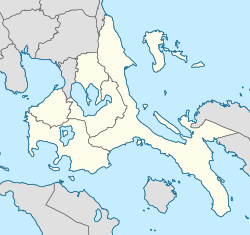This article has multiple issues. Please help improve it or discuss these issues on the talk page. (Learn how and when to remove these messages)
|
Bolbok (officially Barangay Bolbok) is one of the 105 barangays constituting the city of Batangas, Philippines.[2] It is an urban community situated north of the city and is about 5-minute drive from Poblacion. Barangay Bolbok is politically subdivided into three sitios and four puroks: Bolbok East, Bolbok Central, Bolbok East, Rimas, Pulo (Quezon City), Kawong, and Gunaw.[3]
Bolbok
Barangay ng Bolbok Barrio Bolbok | |
|---|---|
Batangas Provincial Sports Complex | |
| Coordinates: 13°46′N 121°03′E / 13.767°N 121.050°E | |
| Country | Philippines |
| Region | Calabarzon |
| City | Batangas City |
| District | 5th District |
| Government | |
| • Type | Barangay |
| • Punong Barangay | Wilfredo G. Ocampo |
| Area | |
• Total | 2.49478 km2 (0.96324 sq mi) |
| Population (2020) | |
• Total | 12,788[1] |
| Time zone | UTC+8 (PST) |
| Postal Code | 4200 |
Etymology
editAccording to the stories told by the old folks, Bolbok's known inhabited portion was so far from the spring which was the main source of water supply for them. There was once a mother with a baby child, who in great need of water, was forced to leave her baby just to fetch water from the spring.
While carrying her jar, she hurriedly set on her foot to the place. After a long walk, she finally reached the spring, filled the jar with water and hurriedly went home, thinking of her baby she had left alone.
Unfortunately, she slipped over the sprouted root of a tree that caused the water in the jar to spill. The mother wept in despair, thinking that if she returns to the spring it will take a long time before she reaches home, and her poor little child was all alone. She wept over the water and knelt on the ground where it spilled.
To her surprise, water began to emerge from the spot where the water had spilled. Water began to flow until it became a spring. She hurriedly filled the jar with water springing from the ground.
On her way home, she continuously uttered “Pagbulbok ng tubig". This phrase became a by-word expression of the people until the place was named "Bolbok", taken from the springing of water from the ground where the water from the jar had spilled out.[4]
Geography
editBolbok is situated at a distance of 2.2 kilometers from the town proper. It is surrounded by neighboring areas, with Barangay Banaba South to the north, Barangay Sta. Rita Aplaya and Barangay Sta. Rita Karsada to the west, Barangay Calicanto and Santa Clara to the south, and Barangay Alangilan and Barangay Kumintang Ilaya to the east.
Demographics
edit| Year | Pop. | ±% p.a. |
|---|---|---|
| 1990 | 6,845 | — |
| 1995 | 8,552 | +4.26% |
| 2000 | 9,727 | +2.80% |
| 2007 | 11,707 | +2.59% |
| 2010 | 11,806 | +0.31% |
| 2015 | 13,270 | +2.25% |
| 2020 | 12,788 | −0.72% |
| Source: Philippine Statistics Authority[5][6][7] | ||
References
edit- ^ "2020 Census of Population and Housing (2020 CPH) Population Counts Declared Official by the President | Philippine Statistics Authority". psa.gov.ph. Retrieved July 12, 2021.
- ^ "Philippine Standard Geographic Code (PSGC) | Philippine Statistics Authority". psa.gov.ph. Retrieved 6 March 2023.
- ^ "Philippine Standard Geographic Code for Barangay Bolbok (PSGC) | Philippine Statistics Authority". psa.gov.ph. Retrieved 25 July 2024.
- ^ "About Bolbok | Batangas City Official Website". batangascity.gov.ph. Retrieved 25 July 2024.
- ^ Census of Population (2015). Highlights of the Philippine Population 2015 Census of Population. Philippine Statistics Authority. Retrieved 20 June 2016.
- ^ Census of Population and Housing (2010). Population and Annual Growth Rates for The Philippines and Its Regions, Provinces, and Highly Urbanized Cities (PDF). National Statistics Office. Retrieved 29 June 2016.
- ^ Censuses of Population (1903–2007). Table 1. Population Enumerated in Various Censuses by Region: 1903 to 2007. National Statistics Office.


